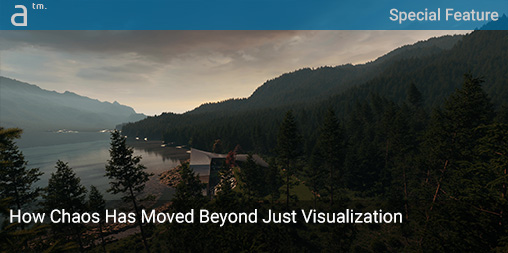CHAOS IS MORE THAN VISUALIZATION; the entities that merged the Bulgarian-based Chaos Group and the German Enscape have formed together the fifth-largest AEC software firm in the world, with a concentration on serving the architecture market. Yet, Chaos doesn’t make any design software in the traditional sense of the word.
However, that is okay for now because Chaos is focused on the “design workflow” space.
Design Workflow Space
When the two companies merged back in 2022 with the help of venture capital firms TA Associates (in America) and LEA Partners (in Germany), Stefan Dandle, principal of TA, stated that “together, we believe the company can build on its strong momentum to create a global leader in the 3D visualization and design workflow space.”
The “design workflow” side of the market (referred to as “space” in the quote above) is one of the fastest areas of change in the larger AEC software industry as AEC professionals, especially architects, take on the use of many more software tools with increasing specialties. Roderick Bates of Chaos, who is Head of Product Operations, refers to this as “unbundling the [design] process into more discreet tools.”
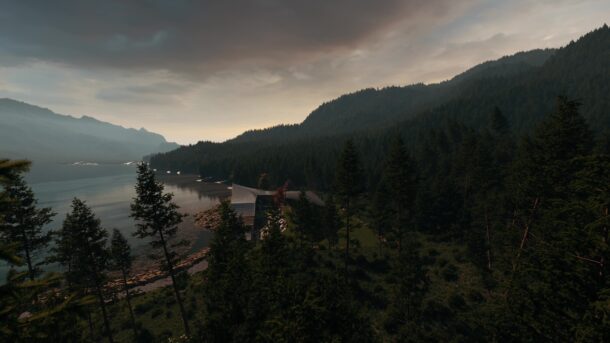
Chaos’ new Envision aims to dramatically simplify and broaden the capabilities of those who design built environments and aim to communicate their visions. This includes new capacity to simulate environments and not just render what they look like. People, vehicles, and other types of objects can be made to move in life-like ways.
Chaos is mainly known as a maker of rendering software programs—especially its famous V-Ray renderer and now Enscape. However, its first software tool addressing what the company calls the “design track” is about helping architects manage energy usage in architecture.
The Second Screen Phenomenon
“It’s our first new product that is outside the realm of visualization,” adds Bates, who further adds, “After talking to our customers and asking them ‘why do you use Enscape?’ they would say ‘I’m using it because it is kind of like this second screen when I am using Revit or what-have-you and I get to have this new view [of the building] at the same time.’ “
It was that kind of comment that partly generated the idea that a rendering software company could also play a larger role in the creation of software that would act as a sort of “design companion.” For Enscape users, Bates said, “their use of the software wasn’t centered principally on the final render, though for many users that is the case, but rather as this design companion view. We began to think about what other kinds of information would be nice for people to have right at their fingertips.”
…they would say ‘I’m using it because it is kind of like this second screen when I am using Revit…
Enscape Impact is the first kind of workflow space product where an issue in the design workflow confronting owners and their architects is how to design buildings that cost less energy to run. As Architosh has covered in detail in the past, Enscape Impact is a building performance add-on to the regular version of Enscape, which is itself a rendering plugin for AEC industry design authoring tools.
MORE: Q&A with Chaos Enscape—Improving the Design Workflow
What Enscape Impact does is visualize building energy performance. “What you are talking about here is something that is analysis, and sure, it could have been done another way,“ says Bates. “It could be just a number, a bar chart, or something communicated verbally, but now you are seeing it in a way that is integrated into the model itself.”
“In this case, we are doing something that AI isn’t doing yet,“ he adds.
Validity for Energy Design
Bates, who is the original author of Tally, a life cycle assessment (LCA) program developed by architecture firm Kieran Timberlake, says, at first, folks they approached about the idea of Enscape Impact thought they were oversimplifying what is really going on with energy analysis. “People would say, ‘You need a ton of data in order to get actionable outputs.'”
It turns out that one of the few companies that produces energy analysis engine software loved the idea. “When we approached IES, they were like, ‘I think we can do this.‘ They were, ironically, the last people we thought would like the idea of Impact, but they did. Part of the reason for that was that their software tools were quite complex for architects, and they were just completely cut out of the day-to-day architectural design space,” he adds.
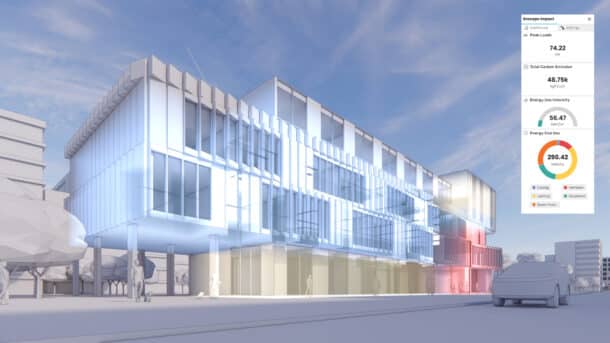
An image of Enscape Impact showing how architects can visualize energy design in architecture. The software helps architects and designers understand the impact of their design on the energy consumption side of architecture.
Enscape Impact gives them access to the architects without cannibalizing their own tools made for engineers and energy consultants. “We also knew that to make this work, we needed to make energy analysis just as accessible as visualization in Enscape.”
Impact uses the same Apache energy analysis engine as IES software solutions. Rather than tons of data inputs like in IES software, in Enscape Impact, the user provides the geometry, the room type, the building’s location, the building’s purpose, and what year it was built or renovated. From there, Impact selects the appropriate template from thousands of IES templates in its database and runs the data behind the scenes.
“So based on all that,“ says Bates, “the template says for this geometry, and this orientation, this is what a code-compliant building would be. So again, the number of inputs is small, but we end up with an output that is surprisingly accurate.”
MORE: Chaos launches Envision: Immersive presentations for architects
In fact, Impact is within two percent of the accuracy of the IES software itself. If the design changes, the energy analysis results are redone, and when this happens, the new results are within 1.5% different than IES. “So now we know what the impacts are, and we can make strong judgments about design changes,“ says Bates, which is what the whole software is about.
Enscape Impact is about evaluating building performance impacts via design iterations and changes.
Design Track Specialties
When thinking about AEC software, Chaos has moved away from thinking about traditional tools that handle just one thing, be that modeling, CAD, BIM, or rendering. In analyzing challenges confronting design workflows, new ideas for software come into focus, even if that kind of software already exists today as its own software island.
That’s just the point: de-siloing the software sector in AEC means being able to move data around between various tools in the design workflow space.
Customers we spoke to about this want Radiance, but initially we wanted to use V-Ray because of speed.
Enscape Impact will begin the research phase for new features such as daylight analysis later this year, says Bates. The company will likely use the Radiance daylight engine and may also include the V-Ray engine. “Customers we spoke to about this want Radiance, but initially we wanted to use V-Ray because of speed,“ he says. V-Ray is about 3x faster.
Daylight analysis is another data set that aids the architect in data-driven design workflows. Bates says they are currently developing human comfort, which is already partially subsumed in Impact’s energy analysis but would be further clarified more broadly with the inclusion of criteria like daylight analysis.
Where Chaos is Going
In thinking about the workflow space and how many different kinds of data could be visualized or communicated in that “second window,” I had to ask the question, Where is Chaos going?
“From our perspective, we want Chaos to be able to deliver the full spectrum design toolkit for AEC,“ says Bates.
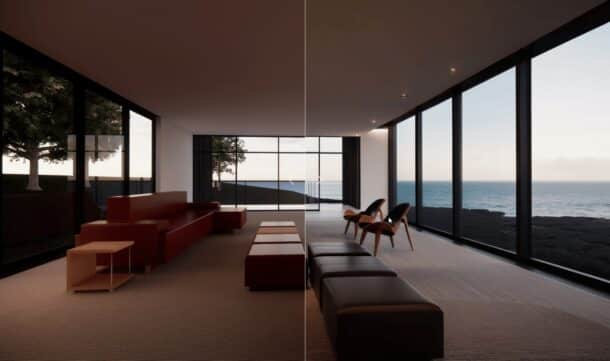
Enscape + Veras together in this image (left to right), showing how Veras provides AI technology to the visualization process. Chaos continues to expand its product portfolio through strategic acquisitions. (see next section in article below).
“Right now, we have a big plan for the “A,” and we essentially have almost no play in the “E“ and “C.“ That is not to say Chaos doesn’t have engineers and construction professionals as customers—they do. “We have worked really hard in Enscape to identify core workflow challenges faced by architects, and then address them with software solutions, and our intent is to do the same thing across the full AEC continuum.“
Acquisitions and Expansion
With that mission clarified, Chaos is aiming for larger things, and one pathway to reaching targets is through strategic acquisitions. The latest one is EvolveLAB, a US-based developer of AI-powered tools for architectural design, which was announced this February.
In 2023, the company bought AXYZ for its popular Anima software for human simulation in architectural rendered animations. It then recently added vehicle and traffic simulation to that product.
Not strictly an AEC software company, Chaos also provides software in the DCC (digital content creation) market or its subsector media & entertainment (M&E), where tools like Autodesk 3ds Max and Autodesk Maya play large roles, along with tools like Maxon’s Cinema 4D.
V-Ray, its flagship high-end renderer, is just such a product, but the company also has Chaos Phoenix for smoke, fire, and fluid special effects in both Max and Maya. And its Chaos Arena is the first-ever real-time path-tracing solution for in-camera visual effects on virtual production stages.
From our perspective, we want Chaos to be able to deliver the full spectrum design toolkit for AEC.
However, returning to the AEC industry, Chaos’ next big gambit is Envision, a 3D scene assembly, real-time animation, and storytelling software for visualization professionals. With Envision, projects can start in either Enscape (fully accessible to most architects) or V-Ray (the dominant tool for professional ArchViz pros), as well as by using one of the free Chaos VR scene file exporters, all of which feed directly into Envision. Additional file formats will be supported soon, including FBX, OBJ, and USD.
Anima integration is part of Envision and contributes significantly to Envision’s storytelling and movie-making animations. Any object can be moved along a spline path, so trains, trams, or bicycles are all good examples of things that can move in an architectural animation. Objects themselves can have multiple positions in a scene linked to specific segments of an animation’s timeline.
Chaos’s grand vision works by leveraging its internal VR scene format. This enables its various software applications to talk to each other by passing their data between apps—like between Enscape and Envision—via the VR scene file format.
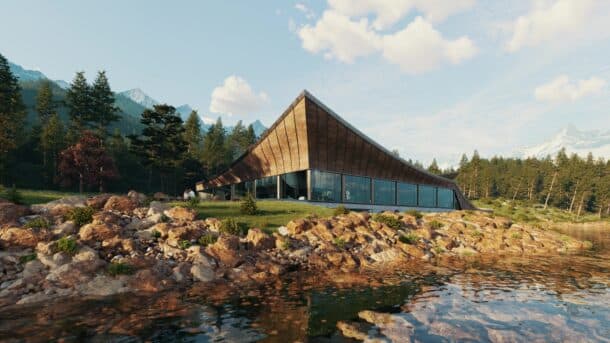
Another sample image from the exciting new Chaos Envision product. More details about the new Envision can be found here.
While OpenUSD continues to gain momentum, Roderick Bates says the VR scene file format has more capabilities for what they want to do in the world of visualization. “I think we will need to play nice with OpenUSD in the future,“ he adds, “especially since I am hearing from multiple sources that OpenUSD is being asked to carry BIM data in it in the future. And once that happens, then that may become more of a universal standard in the industry.“
Still, Bates says it will never have the nuanced data that Chaos’ tools have for high-end visualization. “VR scene file format is really remarkable,“ he says.
Closing Thoughts
Tapping into its strength as a visualization software company, Bates asks the rhetorical question about architecture and its communication needs. What is the best way to communicate data or information?
When thinking about larger architectural workflows, the market is ripe with opportunities to expand the ability to bring data to life via graphic communication. That’s the answer to Bates’ question. A good example is the Revit Graphic Override feature defined by Revit filters. This support in Enscape ensures that data filters in Revit transmit their color values to Enscape as well, so Revit models gain higher-end visual quality via Enscape’s renderer while also deploying the Revit Graphic Overrides communication.
And Enscape even supports up to six section planes by supporting Vectorworks’s unique Clip Cubes technology, giving Vectorworks-based architects uniquely complex sectional views fully rendered in Enscape.
In short, Chaos has built powerful flexibility into its rendering engines, VR scene file format, and API-based pipelines and synching technologies, thus opening itself up to various distinguishing features in design authoring programs. But what is really interesting to think about is where Chaos is ultimately headed with its expansion plans and its ability to tie together diverse programs into integrated workflows.

